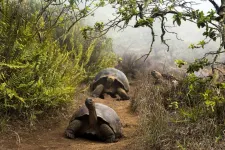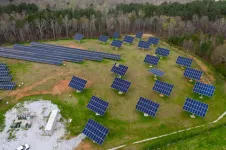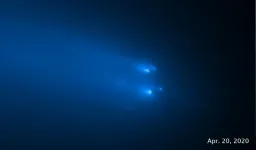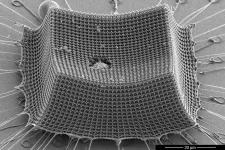(Press-News.org) A new study published in Accident Analysis & Prevention shows how biometric data can be used to find potentially challenging and dangerous areas of urban infrastructure before a crash occurs. Lead author Megan Ryerson led a team of researchers in the Stuart Weitzman School of Design and the School of Engineering and Applied Science in collecting and analyzing eye-tracking data from cyclists navigating Philadelphia's streets. The team found that individual-based metrics can provide a more proactive approach for designing safer roadways for bicyclists and pedestrians.
Current federal rules for installing safe transportation interventions at an unsafe crossing--such as a crosswalk with a traffic signal--require either a minimum of 90-100 pedestrians crossing this location every hour or a minimum of five pedestrians struck by a driver at that location in one year. Ryerson says that the practice of planning safety interventions reactively with a "literal human cost," has motivated her and her team to find more proactive safety metrics that don't require waiting for tragic results.
Part of the challenge, says Ryerson, is that transportation systems are designed and refined using metrics like crash or fatality data instead of data on human behavior to help understand what makes an area unsafe or what specific interventions would be the most impactful. This reactive approach also fails to capture where people might want to cross but don't because they consider it too dangerous and that, if it were safe, more people would utilize.
"Today we have technology, data science, and the capability to study safety in ways that we didn't have when the field of transportation safety was born," says Ryerson. "We don't have to be reactive in planning safe transportation systems; we can instead develop innovative, proactive ways to evaluate the safety of our infrastructure."
The team developed an approach to evaluate cognitive workload, a measure of a person's ability to perceive and process information, in cyclists. Cognitive workload studies are frequently used in other fields of transportation, such as air traffic control and driving simulations, to determine what designs or conditions enable people to process the information around them. But studies looking at cognitive workload in bicyclists and pedestrians are not as common due to a number of factors, including the difficulty of developing realistic cycling simulations.
The researchers in Ryerson's lab looked at how different infrastructure designs elicit changes in cognitive workload and stress in urban cyclists. In 2018, the team had 39 cyclists travel along a U-shaped route from JFK Boulevard and Market Street, down 15th Street to 20th Street, then returning back to 15th and Market. Riders wore Tobii eye-tracking glasses equipped with inward- and outward-facing camera and a gyroscope capable of collecting eye- and head-movement data 100 times per second.
Along with the route being one of Philadelphia's newest protected bicycle lanes at the time, and therefore a new experience for all of the study participants, it also has a dramatic change in infrastructure along the 8-10-minute route, including a mix of protected bike lanes, car-bike mixing zones, and completely unprotected areas. "We felt that, in a short segment of space, our subjects could experience a range of transportation-infrastructure designs which may elicit different stress and cogitative workload responses," Ryerson says.
One of the study's main findings is the ability to correlate locations that have disproportionately high numbers of crashes with a consistent biometric response that indicates increased cognitive workload. If a person's cognitive workload is high, Ryerson says, it doesn't necessarily mean that they will crash, but it does mean that a person is less able to process new information, like a pedestrian or a driver entering the bike lane, and react appropriately. High cognitive workload means the threat of a crash is heightened.
In addition, the researchers found that stressful areas were consistent between expert cyclists and those less experienced or confident. This has implications for current approaches to managing safety, which typically focus on pedestrian- and cyclist-education interventions. Education is still important, Ryerson says, but these results show that infrastructure design is just as important in terms of making spaces safe.
"Even if you're a more competent cyclist than I am, we still have very similar stress and workload profiles as we traverse the city," says Ryerson. "Our finding, that safety and stress are a function of the infrastructure design and not the individual, is a shift in perspective for the transportation-safety community. We can, and must, build safety into our transportation systems."
The Ryerson lab is now analyzing a separate eye-tracking dataset from cyclists traveling Spruce and Pine streets before and after the 2019-20 installation of protected bike lanes, an experiment that will allow closer study of the impacts of a design intervention.
Overall, Ryerson says, the research shows that it's possible to be more proactive about safety and that city planners could use individual-level data to identify areas where a traffic intervention might be useful--before anyone is hit by a car. "The COVID-19 pandemic encouraged so many of us to walk and bike for commuting and recreation. Sadly, it also brought an increase in crashes. We must proactively design safer streets and not wait to count more crashes and deaths. We can use the way people feel as they move through the city as a way to design safer transportation systems," she says.
INFORMATION:
The complete author list is Megan Ryerson, Carrie Long, Michael Fichman, Joshua Davidson, Kristen Scudder, George Poon, and Matthew Harris from Penn; Michelle Kim from Swarthmore; and Radhika Katti from Carnegie Mellon University.
COLUMBUS, Ohio - Flavor is the name of the game for scientists who want to optimize food for consumption in ways that improve nutrition or combat obesity.
But there is more to flavor than the substances that meet the mouth. Olfaction, our sense of smell, is a major contributor to how we perceive aromas, especially those related to what we eat.
With hopes to capitalize on the smell factor in flavor development, researchers are exploring how the route an aroma takes to get to the olfactory system, through the nose or the back of the throat, influences our response to the scent in question.
In a new study, when participants were asked to match a known scent such as rose with one of four unknown scents, they did best when the aromas were introduced ...
Champaign, IL, July 19, 2021 - For dairy cows, the transition period--the time between a cow giving birth and beginning to produce milk--brings the greatest possibility of health problems. The current widespread belief is that the effects of excess nonesterified fatty acids (NEFA) in the bloodstream and the ensuing hyperketonemia during this period, coupled with low levels of available calcium, are largely responsible for disorders such as mastitis, metritis, retained placenta, and poor fertility. Much attention has therefore been devoted to regulating NEFA and calcium levels in transition cows--yet all these efforts have not made the transition period less of a challenge to cows and, hence, to farmers, with approximately ...
The second dose of a COVID-19 vaccine induces a powerful boost to a part of the immune system that provides broad antiviral protection, according to a study led by investigators at the Stanford University School of Medicine.
The finding strongly supports the view that the second shot should not be skipped.
"Despite their outstanding efficacy, little is known about how exactly RNA vaccines work," said Bali Pulendran, PhD, professor of pathology and of microbiology and immunology. "So we probed the immune response induced by one of them in exquisite detail."
The study, ...
The MOMAT research group from Universidad Complutense de Madrid has worked with Universidad de Almería, to develop a mathematical model that simulates the impact of SARS-CoV-2 strains and vaccines together, combined with many other biological and social processes in the propagation of COVID-19.
The tool can be downloaded without restriction and free of charge and applied to any territory. It forms part of the family of θ-SIR models, which were initially developed by the MOMAT research group itself before the arrival of new variants and the development of vaccines.
"The model allows us to estimate for the first time ...
UCC-UCM, 13 July. The Giant Galapagos tortoises which live in contact with human farming and tourism activities, or in urbanised zones, have more bacterial resistance to antibiotics than those that live in more isolated ecosystems.
This is the main conclusion of the research published in Environmental Pollution on which Universidad Complutense de Madrid participated together with the Charles Darwin Foundation (FCD), the Institute for Conservation Medicine of the Saint Louis Zoo (ICM), the Centre for Animal Health Research (INIA-CISA) and Universidad Europea de Madrid.
Ainoa Nieto, the lead author, researcher at ICM/FCD and collaborator ...
Analysis of children and young people's proximity to woodlands has shown links with better cognitive development and a lower risk of emotional and behavioural problems, in research led by UCL and Imperial College London scientists that could influence planning decisions in urban areas.
In what is believed to be one of the largest studies of its kind, researchers used longitudinal data relating to 3,568 children and teenagers, aged nine to 15 years, from 31 schools across London. This period is a key time in the development of adolescents' thinking, reasoning and understanding of the world.
The study, published in Nature Sustainability, looked at the links between different types of natural urban environments and ...
When it comes to transitioning from carbon-based to renewable source energy systems, Americans are on board. They're less keen, however, having these new energy infrastructures--wind turbines or solar farms--built close to their homes, which creates hurdles for policymakers. That's according to a study from University of Georgia researcher Thomas Lawrence.
Lawrence and an international team conducted surveys in the United States, Germany and Ireland to assess people's attitudes about renewable energy technologies and their willingness to have the necessary infrastructures built nearby.
"People in Germany and Ireland were more open to having renewable ...
A serendipitous flythrough of the tail of a disintegrated comet has offered scientists a unique opportunity to study these remarkable structures, in new research presented today at the National Astronomy Meeting 2021.
Comet ATLAS fragmented just before its closest approach to the Sun last year, leaving its former tail trailing through space in the form of wispy clouds of dust and charged particles. The disintegration was observed by the Hubble Space Telescope in April 2020, but more recently the ESA spacecraft Solar Orbiter has flown close to the tail remnants in the course of its ongoing mission.
This lucky ...
RESEARCH TRIANGLE PARK, N.C. -- Army-funded research identified a new material that may lead to lightweight armor, protective coatings, blast shields and other impact-resistant structures.
Researchers at the U.S. Army's Institute for Soldier Nanotechnologies at the Massachusetts Institute of Technology, Caltech and ETH Zürich found that materials formed from precisely patterned nanoscale trusses are tougher than Kevlar and steel.
In experiments, the ultralight structures, called nanoarchitectured materials, absorbed the impact of microscopic projectiles accelerated to supersonic speeds.
"Increasing protection while simultaneously decreasing the weight that ...
It's no secret that studies show that sexually diverse youth - in particular, lesbian, gay and bisexual (LGB) youth - use more cannabis and experience more mental health challenges than their heterosexual peers.
But what about the changes that occur in the rates of cannabis use: do they precede those related to mental health or is it the other way around? A new study from Université de Montréal offers some answers.
In the Journal of Abnormal Psychology, Kira London-Nadeau, a doctoral student and CIHR Vanier Scholar in the Department of Psychology at UdeM and the CHU Sainte-Justine Research ...




